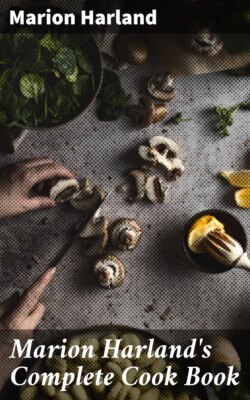Читать книгу Marion Harland's Complete Cook Book - Marion Harland - Страница 8
На сайте Литреса книга снята с продажи.
ОглавлениеCARVING
Table of Contents
The present mode of serving meats after the manner of the table d’hôte—the carving done in the kitchen, and the results placed upon the platter to be served to the guests by butler or waiter—has in large measure done away with the demand for hints to the master or mistress of the home upon the art of carving. To those who adhere to the earlier custom, directions can be merely outlines; for the single means by which one may become an adept as a carver is in the repeated practice which is required for skill in any work of manipulation.
A prerequisite to carving is appropriate implements. The knife, the edge of which has been dulled upon the bread-board, or hacked in the offices of the kitchen, where it has been employed as the scullion’s tool, may puncture and tear, but it will not carve. In the hand of even the most skilful it is exasperation.
The mistress of the home owes it to the head of the table, as well as to the ease of mind of her guests, to see that the carving set—the knife and its companion fork—shall be in the best condition for their work.
To carve a roast of beef
This will depend upon the form in which the roast is placed upon the platter. If it include several ribs, furnishing sufficient room for a base of bone, it may be so put before the carver that he may cut perpendicularly in thin slices, passing the knife in a line parallel with the ribs. If, however, the roast be laid upon the side, as is usual, the same direction is to be observed as to the cutting in lines parallel to the ribs.
Where a tenderloin roast is to be carved—having but the one large bone which divides the tenderloin from the more solid portion—there is little choice whether the knife is drawn with or transversely to the grain: the tenderness of the meat is assured in either case. It may be more convenient to sever entirely the tenderloin from the firmer part of the roast before beginning to slice. This will leave the carver at liberty to serve a portion of each quality of the meat to every guest, as the tenderloin may not be of sufficient size to serve to all.
To carve a leg of lamb or mutton
If the small ribs—which are generally taken off for chops—are left with the leg, the carver is free to ask the preference of each guest for the rib or solid slice. The chops may be detached by drawing the point of the knife between the ribs, and—if the butcher has properly done his part—in severing the light cartilage at the backbone, as in parting vertebræ. The fleshy portion of the leg will be more tender if cut in slices at a right angle with the bone, as one would carve a ham; that is, across the grain. Some carvers, however, prefer to cut lamb or mutton with the grain, as it enables them to serve a portion more or less thoroughly cooked, according to the preference of those to be helped. These directions apply equally to carving a haunch of venison.
To carve poultry
The fowl—whether turkey, chicken or duck—should be placed on its back upon the platter. This will permit the carver to transfix the breastbone firmly with the fork; for, upon the stanchness of the hold here will depend the success of all further operations. The wing from the nearer side should first be dissevered by a gash of the knife underneath the socket. This, if the fowl be tender, is easily accomplished with a single cut. The first and second joints of the leg may next be separated, and the second or upper joint removed from its junction with the body, as was the wing. This is easily effected by a slight cut and pres sure of the bone outward. The sidebone may be taken off by running the blade directly along the backbone; for it adheres only by a filament of skin and the soft fat that attaches to it on this line.
These joints having been taken off, the breast is now entirely exposed, and further carving is a very simple matter. The removal of the leg has laid bare the cavity, from which the dressing may be lifted with a spoon, and the cutting of a few slices from the breast, near the neck, will open the crop with the stuffing usually placed there to plump the fowl. The main joint and the pinion of the wing may be severed by cutting the cartilage at the junction of the two bones.
To carve fish
There is an art in carving fish, and it is confined to a single direction. It is to open with a knife at the back, drawing the blade the whole distance from head to tail just above the backbone, and pressing the meat loose from its fastening. Portions may then be served by cutting transversely with the backbone. Fish so carved is freed from the intricate mass of small bones which are sure to mingle with the flesh if it be cut in any other way. The head, if not already removed, should first be taken off, and the collar or shoulder-bone lifted from the fish.
